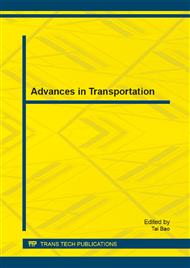p.154
p.163
p.168
p.174
p.180
p.184
p.188
p.192
p.200
Pavement Roughness Indices Related to Riding Comfort
Abstract:
The most widely used pavement roughness index is the international roughness index (IRI), but it is a poor predictor of ride comfort. In addition, the rider has not yet been included in the vehicle model used to evaluate pavement roughness. In this paper, in order to evaluate the comfort of the rider directly and consider the effects on ride comfort of pitch movement, a five-degree-freedom vibration model was built when a rider was added to a pitch-plane vehicle model. The vertical weighted root-mean-square (RMS) acceleration of the rider was suggested to be pavement roughness indices, which were related to ride comfort, respectively. The new roughness indices were calculated and a new pavement roughness evaluation method was developed.
Info:
Periodical:
Pages:
180-183
Citation:
Online since:
January 2014
Authors:
Price:
Сopyright:
© 2014 Trans Tech Publications Ltd. All Rights Reserved
Share:
Citation:


